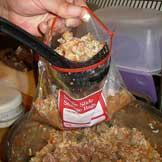
When one of my feline patients isn’t eating, I first try to determine why. Directly addressing the underlying cause (when possible) is essential if we’re going to get and keep the cat eating in the long run. But sometimes, resolving the primary problem takes some time. In these cases, we need a patch to keep us on the road to recovery.
The solution may be as easy as reducing the symptoms associated with the cats primary disease. If the cat is hurting, improving pain control may do the trick. Nausea can at least be partially controlled with medications. Some cats will develop a food aversion when they don’t feel well. It’s as if they believe the food they were eating when they became ill is responsible for their condition (not an unreasonable assumption when you’re not that far removed from your wild ancestors). Try offering a couple of different foods (wet, dry, and various flavors). Warming the food and hand feeding can also help.
If none of this works, and the cat has been inappetant for only a couple of days, I will next try a medication that can stimulate the appetite. Diazepam (Valium) and a related drug midazolam have been used in this role, but they have fallen out of favor. At best, cats tend to take a few bites of food but then get so sleepy they stop eating. Diazepam has also been implicated in causing liver disease in some cats. The drugs mirtazapine and cyproheptadine are better options. An acupuncture/pressure point located on the top of the nose, right at the midline where the haired and unhaired tissues meet is also worth a try.
Appetite stimulants aren’t a good option when a cat has been eating poorly for more than a few days. As we wait to see how effective they’ll be, the cat is probably still not taking in enough calories, which is most likely initiating or worsening hepatic lipidosis. In these cases, I strongly recommend placing an esophagostomy tube (E tube). E tubes are easy to insert, allow the feeding of canned food (in comparison to specially prepared diets) and the administration of medications, have few complications, and cats aren’t overly bothered by them. If vets were quicker recommend and owners quicker to authorize the placement of E tubes, we’d see far fewer cases of hepatic lipidosis and save many lives.

Dr. Jennifer Coates
Image: Thinkstock









